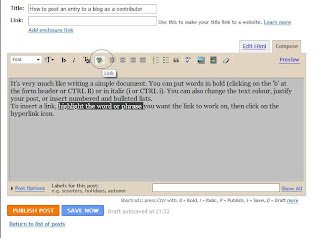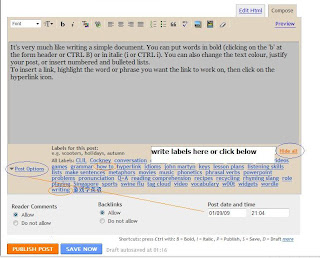Soon, it’ll be the start of the new academic year; don’t wait until the very last minute to think about ideas for the first lesson. To help you, here are a few
tried and tested activities. Some of your students are possibly known to you from previous years, so you’ll probably have an idea as to what will or won’t work with them. If you have a new class, you’ll have to be flexible. Be aware that their level may not be as high as you expect, so have a few plans ready in your mind.
A. Learning names
1. Ask them to imagine they are at a party. Play cheerful music, and while the music is playing, have them walk around the class,
gesturing with their hands and body,
miming some dialogue, etc. with another student. Make sure they change their partners every 5-10 seconds. When you stop the music, they introduce themselves to each other, e.g. “My name’s Lara, What’s yours?” When the music is resumed, they change partners again, and when it is stopped, they ask their new partner the same question.
At the end of the activity, ask them how many names they have remembered, pointing out the student as they mentioned their names, e.g. he’s Pablo, she’s Carolina.
If you like, you can have them extend the conversation to include things about themselves. Write key words/expressions on the board: family, hobbies, pets, favourite things (football team, food, music, etc.), dislikes, and so on. At the end of the activity, check what they remember.
2. Instead of freely moving around the class, you can arrange them in two concentric circles, or in two lines, facing each other (see
Ideas for practising dialogue).
3. Test their memory: the first student says, ‘My name’s María.’ The next say, ‘Her name’s María and mine’s Pablo.’ The following student says, ‘Her name’s Maria, his is Pablo and my name’s Samuel.’ This carries on until the chain’s too long for them to remember!
4. If you see they enjoyed that, you can add another piece of information, e.g. ‘My name’s María and I have two sisters.’
In these activities, it’d be best if you include yourself. Apart from learning their names
firsthand you’ll be demonstrating to them that you intend to create a communicative atmosphere in your classroom.
B. Chain Whisper
You can combine learning names with another activity, such as
Chinese Whispers. Ask them to form a line, but with a particular criteria which you choose. For example, you can tell them you want them in alphabetical order of their first names. Explain how the conversation should go. Write them on the board, if necessary:
What’s your name?
María.
Erm..., I’m before you – my name’s Javier.
The Chinese Whispers activity can be used to incorporate English sounds into the first lesson, too. Use the line formed as above, or form a circle. Whisper either a
phoneme or a word or phrase which include the sound you’d like to demonstrate, to one student. She or he whispers what you said to the next student, and so it carries on until the last student. The last student announces the sounds or words to the whole class. You correct, if necessary.
C. Questions
From my experience, I have found that learners have tremendous problems constructing questions correctly. You could plan a questions activity to
gauge their knowledge on this aspect and, if necessary, write down examples on the board for them to follow. You can always explain them in subsequent lessons.
1. Ask them to write between 3 to 5 questions on a piece of paper. While they are preparing their questions, monitor their mistakes, and help them if they have difficulties. Write examples on the board. Get them into one of the formations explained in the ‘
ideas for practising dialogues’ post. They ask their partners the questions. At the end of the activity, they report their findings to the class. Example:
• Pedro, Tania, Sonia and Paula don’t like animals, but Carlota has a dog and two birds.
• Susanna has three sisters. Pablo has four brothers.
• Javier likes rock music, but Raquel can’t stand it.
2. Instead of asking the questions, they predict the answers first. Later, they report it to the class: I guessed that Paul likes salsa music, but he doesn’t. I thought that María has one sister, but she has none.
3. You could also have them asking you the questions instead of their classmates. Add some variance to this by telling them they can only ask questions which require a yes or no answer, or give them three different answers and they have to guess the right one. This may get rather noisy, so allow the questioner the first guess.
D Ask someone who
Write a few instructions on the board:
• Find someone who hates cats
• Find someone who lives near you
• Find someone who loves Japanese food
• Find someone who likes the same type of music as you
Make sure they know how to structure the questions. At the end of the activity, they tell the class what they have discovered.
E Vocabulary test
Choose a
criterion and
brainstorm all the words that fit it. If it’s a complete beginner’s class, ask for any English words they know. Examples of criteria you could use are words beginning with a certain alphabet, words of a certain length, or a combination of both, e.g. all 3-letter words beginning with K. The choice is limitless. Increase the challenge by further restricting the selection to nouns, proper nouns, adjectives, or verbs.
F End of Lesson
You may like to experiment this with your class – decide if there is enough
rapport between the students and you for this to work. It is basically a relaxation exercise, an extension of meditation techniques, but is now gaining popularity in pedagogical circles under the
guise of names such as stilling, visualization, scripted fantasy and guided imagery. Leave yourself about 10-15 minutes before the end of the lesson. The activity consists of first relaxing the students, then transporting their mind through a
fantastical journey. For the latter, use your imagination, or an appropriate text from somewhere such as text books or stories.
Soft
soothing music is optional.
Explain words they might have difficulty with before you start. You don't want any interruptions once you begin.
Speak to them in your most relaxed and calming voice, soft but loud enough for everyone to hear. It is best if they’re seated in a circle, but if this is not possible, decide if it is better for you to be seated somewhere in the middle or in the front (or at the back) of the classroom.
Close your eyes... Straighten your back... Sit deep in your chair, your back against the back of the chair...Put your hands on your lap...Both of your feet are flat on the floor.
Clench your fist... now relax them and feel them open.
Curl your toes...now relax them slowly.
Take a deep breath...let it out slowly...take another breath, slowly and deeply...feel your stomach expand outwards as you breathe in...breathe out slowly.
Do this a couple of times until you find them sufficiently relaxed.
Now, listen to the sounds in this room...listen to your own breath...feel it entering and leaving your body...feel your blood flowing from your heart down your left arm and up...down your left side of your body...down your left leg and up again...now it moves down your right leg...and up...down your right arm...and up...up your head...moves round, then down back to your heart.
Keep your eyes closed, but feel your third eye opening, this is your mind’s eye...look at the door...it opens...we’re leaving the classroom...we’re walking down the corridor...there isn’t anyone; they’re all in their classes...through the windows, you see that it’s a sunny day...we walk down the stairs...we walk through the door, into the open...
Feel the wind blowing into your face...feel the sun shining...feel its heat on your skin...hear the sounds of the cars...hear the birds singing...Breathe in the fresh air...
Ok, now we turn back...we walk back indoors...feel the sunlight behind you...we walk up the stairs...through the corridor....the classroom door opens...
Walk slowly to your chair...sit down gently...feel your breath...in...out...in...out...now, slowly open your eyes...move your fingers and your toes...look around you slowly...
If there is time, you might like to ask them if they had enjoyed the experience. Make sure they get up slowly and not rush out of their seats like they usually do! The body (and the mind) needs to get back to the ‘normal’ world gradually: If they stand up
abruptly they might feel
dizzy.





